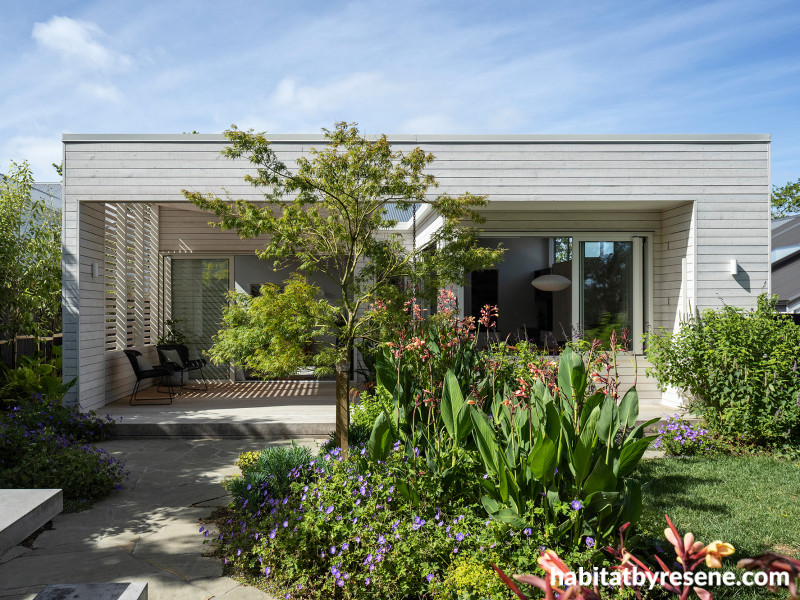
Take it outside: The top Resene paint and stain colours being used outside
14 Oct 2024
It seems almost like clockwork. As soon as the first whispers of warmer weather arrive, more clients come knocking looking to fresh up their exterior colour scheme. But for many, choosing colours for an exterior can feel more daunting than selecting interior hues because the stakes are higher, both in terms of visibility and context. Unlike interior selections, exterior paint and stain colours are always on public display and contribute to the overall streetscape or surroundings. This added visibility often creates pressure, as your clients likely want to ensure that their choices are aesthetically pleasing not just to themselves but for neighbouring property owners and passersby.
Context also plays a significant role in how exterior paint colours look. Factors like architectural style, hues used on adjacent structures, landscaping, the surrounding natural environment, light direction and sun exposure can dramatically affect how your colour selections will appear once used on a building’s exterior. A colour that appears subtle and nuanced on a paint sample can become washed out when exposed to direct natural light. Relativity is another factor, as a hue that looks ideal in isolation may clash with the context of nearby buildings or natural features once it’s applied at scale.
When you’re not sure where to start, looking to the Resene colours that other designers, builders and painters have used on similar projects can help. Since many professionals who are tasked with selecting exterior paint colours in New Zealand and Australia tend to choose tones depending primarily on the architectural style of their project while also being sympathetic to its surroundings, we have broken down today’s top exterior colour trends by typology and style. Get inspired by these eye-catching Resene colour combinations used on recent renovations and new builds and brush up on our handy tips to help guide your paint and stain colour selections on your upcoming projects.
Residential homes
For residential renovations and repaints, neutral hues such as whites, off-whites, pale greys and light taupes are top choices. These options offer versatility, a clean aesthetic and reflect a high degree of sunlight while contrasting with the lush tones often seen in our natural surroundings. Among the most popular whites and off-whites are Resene Alabaster, Resene Black White, Resene Sea Fog,Resene Villa White, Resene Rice Cake and Resene Merino. With white and off-white homes, darker neutral tones like Resene Element and Resene Half Tuna work well as a bold contrast on trims, fascia and roofs, helping to anchor the design and add definition to lighter base colours. Likewise, metal roofs in Resene Bokara Grey or Resene Ironsand complement the lightness of white and off-white homes without the risk of clashing with colours that have been used for neighbouring properties.
Light grey shades like Resene Gull Grey or Resene Half Stack are also common choices for suburban homes. Greys provide a sophisticated and neutral option for building out the rest of the palette and it’s often easy to pair with natural materials like stone or timber. Pairing a light grey base with crisp white trims, soffits, fascia, fretwork and finials in hues like Resene Quarter Black White can highlight these architectural details and provide fresh contrast. On roofs, darker shades like Resene Grey Friars work well for creating a balanced look while ensuring the roof colour doesn’t visually overpower the lighter greys or the home’s form.
In rural settings, taupes and earthy tones like Resene Half Fossil, Resene Canterbury Clay, Resene Bison Hide, Resene Lemon Grass or Resene Flax are appropriate options for blending with the landscape. These colours echo the natural hues seen in rural surroundings while enhancing the harmony between the built environment and nature. Warm whites or soft creams like Resene Half Rice Cake and Resene Quarter Thorndon Cream can be used for trims to maintain a cohesive, natural feel white a deep green or a burnt red such as Resene Midnight Moss or Resene Pioneer Red on the front door adds an earthy pop of colour that can still connect with the landscape while adding personality to the design.
Darker tones like Resene Woodsman Pitch Black, Resene Woodsman Charred Black, Resene Element and Resene All Black are hot options for new builds with contemporary forms. These dark hues create a striking, modern look, especially when paired with large windows and contrasting timber details stained in Resene Colorwood Natural. Subtle contrasts with deep greys or soft blacks like Resene Zeus or Resene Nero for trims, window frames and soffits can help maintain a cohesive yet dynamic appearance. Carrying the same hue or a similar charcoal or dark tone like Resene Bokara Grey on to the fascia and roof creates a sleek, seamless look and adds a modern edge to the design. It’s also not unusual to see a small pop of colour used on fascia, sunshades or doors in hues like Resene Ayers Rock,Resene Havoc or Resene Bright Spark.
Top tip: When choosing darker colours outdoors, opt for a ReseneCoolColour formula. A ReseneCoolColour looks the same as a standard Resenecolour, but thanks to special pigment technology, the ReseneCoolColour will reflect more harmful UV light and heat away from the surface to help protect the integrity of the substrate.
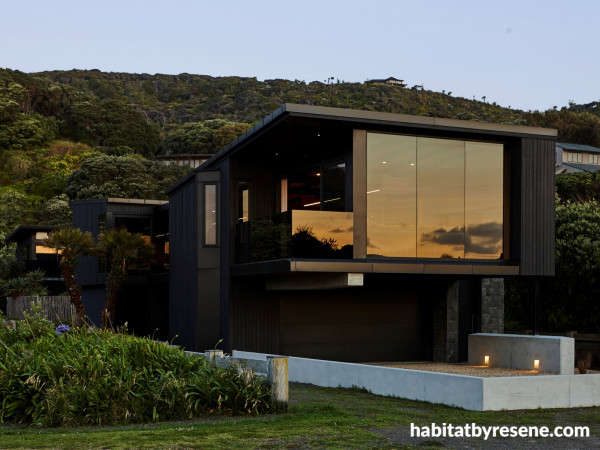
Timber weatherboard stained in Resene Woodsman Pitch Black with aluminium window frames, door frames and fascia in ReseneBlack. Project by Daniel Marshall Architect Ltd, build by iCreateBuilding & Renovations Ltd, painting by Supercity, image by Jackie Meiring.
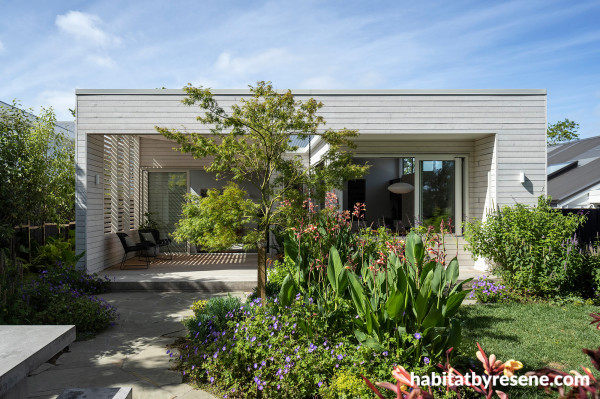
Timber cladding finished in Resene Woodsman Whitewash and trims in ReseneLumbersider Low Sheen tinted to Resene Double Sea Fog. Project by Strachan Group Architects, build by Heartwood Builders, painting by TD Nguyen Painting, image by Simon Devitt.
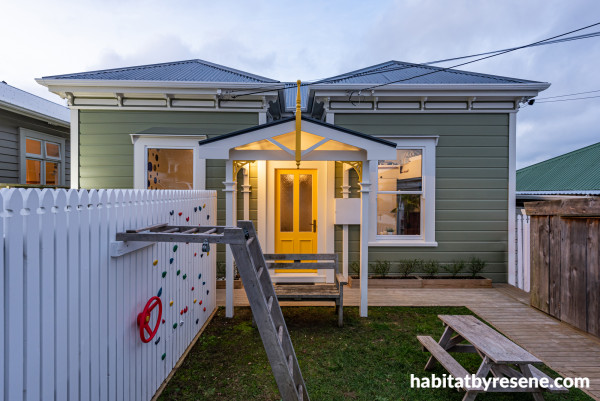
Weatherboards painted in ReseneSonyx 101 tinted to Resene Flax, roof in Resene Summit Roof tinted to Resene Ironsand, trims in ReseneLustacryl semi-gloss, door and finial in ReseneLustacryl tinted to Resene Bright Spark, white fence and gate in ReseneLustacryl tinted to Resene Whiteanddeck and fence (at right) stained in Resene Woodsman Heartwood. Project by Russell Allen Architect.
Commercial and public buildings
For commercial buildings, particularly those located in urban centres, whites and greys like Resene Half Black White, Resene Concrete, Resene Surrender and Resene Half Tuna continue to be popular exterior hues. However, blues and sophisticated dark tones are also trending for properties with industrial design elements.
On some commercial façades, commissioning a mural can add much needed vibrancy to the structure and its surrounding streetscape. On other projects, adding a vibrant yellow, fuchsia, red or orange to highlight design elements adds visual interest and gives the structure a unique look, which could be used for tying in branding colours to commercial offices or retail storefronts. Resene Happy, Resene Lip Service, Resene Jalapeno and Resene Tangerine are some of the most popular choices for adding a pop of colour to commercial exteriors.
Although many commercial and public projects feature relatively safe exterior colour choices, it’s become common for schools to feature bolder selections. Sometimes splashy hues like Resene RSVP might be used to inject energy and fun into the façade, other times a colour might tie into the school’s crest and uniform colours while some projects use bold exterior colours to assist with wayfinding.

Exterior concrete painted in Resene X-200 tinted to Resene Stonehenge (bulk forms) and Resene Quarter Truffle (secondary elements), timberwork and facings in Resene Silver Pearl and Resene Quarter Truffle and entrance doors in Resene Element. Project and image by Cosgrove Goodwin Architects, painting by JPB Painting Contractors.
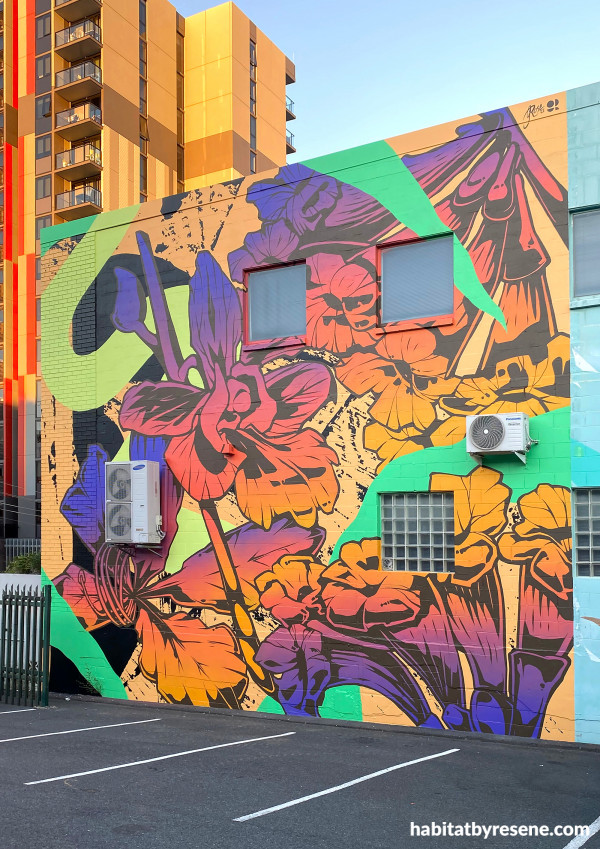
Mural painted in Resene Big Bang, Resene Black, Resene Blue Gem, Resene California, Resene Jacko Bean, Resene Sublime, Resene Touche and a custom Resene colour. Project by George Rose, image by Holly Hawkins.
Heritage buildings
While the colours that can be used to paint many heritage projects are restricted by regulations, covenants and caveats, some projects will have broader guidelines that only require that selections be sympathetic to the architectural style and era. On these types of projects, traditional colour palettes and soft pastels remain popular. Hues such as muted greens, classic reds, creams, pale blues and dusty pinks like Resene Siam, Resene Red Oxide, Resene Bubble White, Resene Duck Egg Blue and Resene Ebb are often chosen to respect the historical character of the structure.
For heritage villas in older suburbs, colours like Resene Villa White and Resene Spanish White are hugely popular. These warmer neutrals preserve the historical charm and blend well with traditional architectural features. Depending on the level of contrast that’s desired, a lighter white like Resene Barely There can be applied to decorative elements like trims and railings or a deeper hue like Resene Mondo can be selected to make these details stand out more. An inky blue black, a heritage-inspired red, a rich green or a grey blue on the front door such as Resene Jaguar, Resene Red Oxide, Resene Gordons Green or Resene Inside Back complements the timeless appeal of these buildings.
Top tip: For an added layer of protection on bold colours like red, orange or purple that have been applied to exterior architectural details, apply topcoats in Resene Clearcoat UVS waterborne UV protective glaze. Formulated with UV absorbers, Resene Clearcoat UVS filters out harmful UV light, protecting the underlying coloured coat.
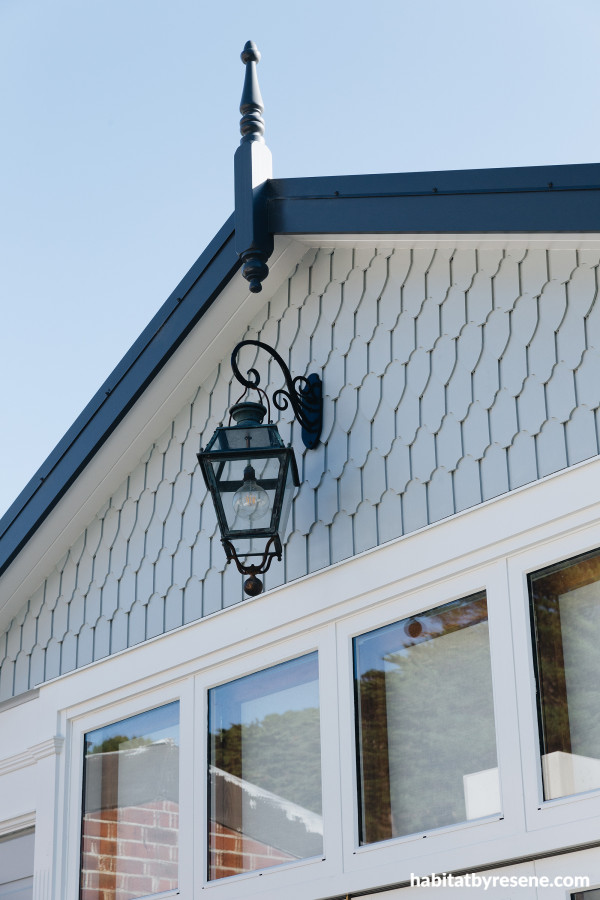
Weatherboard painted in ReseneSonyx101semi-gloss tinted to Resene Gull Grey, finial and fascia in ReseneSonyx semi-gloss tinted to ReseneCoolColour Grey Friars and window trims and soffits in ReseneLustacryl tinted to Resene Sea Fog. Project by Charlotte Minty, build by Hutt City Builders, painting by Pure Painting, image by Bonny Beattie.

Concrete blockwork painted in Resene X-200 tinted to Resene Alabaster, concrete beams and columns in Resene X-200 tinted to Resene Baltic Sea, fascia in ReseneLustacryl tinted to Resene Red Oxide, weatherboard sections in ReseneLustacryl tinted to Resene Siam and garage doors in ReseneLustacryl tinted to Resene Alabaster. Project by Young Architects, painting by Summitbuild Construction, image by Dennis Radermacher.

Base wall colourpainted in Resene X-200 tinted to Resene Half Concrete, vertical accents in ReseneLumbersider Low Sheen tinted to Resene Catskill White, decorative accents in ReseneLumbersider Low Sheen tinted to Resene Spring Rain and Resene High Moon and joinery in Resene Black Forest. Projectby Foundation Architects, build by Ironhorse Construction.
Other key considerations
Keep in mind that your project’s natural lighting circumstances can dramatically alter how your Resene colours will appear once applied. Bright sunlight can wash out paler colours while darker or bolder shades may appear much richer or more intense. Remember that some exterior surfaces also have rougher textures - like stucco, plaster, blockwork or brick - which can cause light to reflect differently compared to the smoother cladding surfaces. Textures can cause shadows to form, changing how a colour is perceived in different lighting or from various angles. Always test your shortlisted Resene colour selections in situ before finalising your specifications. We recommend brushing out a Resene testpot in two coats on to an A2 card, leaving a 2cm unpainted border around the edge to isolate the colour. Move this card around to view it against different elevations at different times of the day to ensure you and your client are happy with your choices.
Some manufacturers of exterior cladding materials impose limits on the Light Reflectance Value (LRV) of paint colours that can be applied to their products in order to ensure their materials’ durability and performance. LRV measures how much light a colour reflects. It’s expressed as a percentage from 0 to 100, with lower values indicating darker colours and higher values indicating lighter hues. Darker shades can cause cladding materials to expand, warp or degrade faster due to excessive heat absorption. By limiting the LRV of paint colours that are applied to their products, manufacturers reduce the risk of heat-related damage, helping to maintain the integrity of the cladding materials and prevent issues like cracking or premature wear. You can easily find the LRV of a Resene paint colour on the back of its swatch or colour card and on the free online Resene Colour Swatch Library. You can also reduce heat absorption by choosing the CoolColour version of your dark Resene colour to help it reflect more heat.
On multistorey buildings, it’s also important to keep in mind that stained timber details at height can be more difficult and costly for clients to maintain than if the same surface were painted as stained exterior surfaces must be recoated every two to three years to protect their substrates from elements. You may be best to keep stained finishes on the ground floor and have painted features on higher levels.
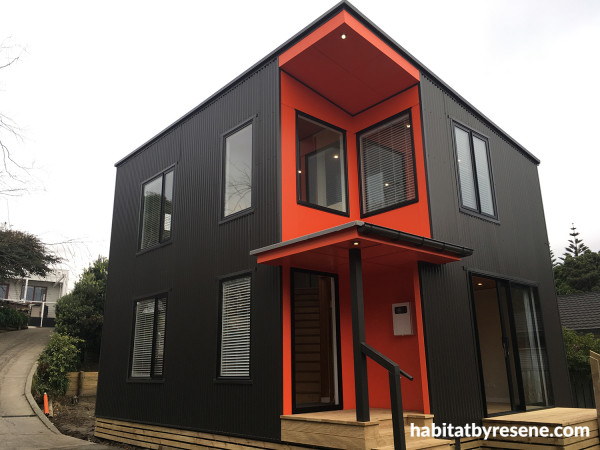
Entrance feature painted in ReseneLumbersider Low Sheen tinted to Resene Tangerine. Project by Hunter Architecture, build by Rusty Construction Ltd, painting by Mark Sharrock Painting and Plastering, image by 16-Nine Photography.
For more on the latest colour and decorating trends – inside and out – check out the most recent issue of Black White magazine or the latest edition of habitat plus – decorating and colour trends.And for more exterior colour tips and considerations, read this story from Issue 08 of Black White magazine.
Published: 14 Oct 2024














 look book
look book